This CE Center article is no longer eligible for receiving credits.
Speech Privacy Potential
At 30 dBA, the masking sound is barely audible and yet provides the minimum necessary to accurately plan the remaining elements of the acoustical design. However, there are significant opportunities for further value engineering. As partition attenuation increases, for each decibel reduction there is an increase in speech privacy levels. Mathematically, the same can be achieved by raising the background sound level by a decibel.
When preparing “Sound & Vibration 2.0: Design Guidelines for Health Care Facilities”—the companion document to the Facility Guidelines Institute’s (FGI) “2014 Guidelines for Design and Construction of Hospitals and Outpatient Facilities”—acousticians developed a formula that provides a predictive model for this approach. Basically, to “achieve confidential speech privacy, the sum of the composite STC and the A-weighted background noise level shall be at least 75,” or STCc + dBA ≥ 75. Some refer to this formula as speech privacy potential (SPP). Though developed with a particular type of facility in mind, most people expect conversations occurring within closed rooms to remain private, making SPP more broadly applicable. Note that STCc includes the negative impact on acoustic performance when elements such as doors and windows are added to the partition.
If speech privacy equals STCc + 30 dBA ≥ 75, then for every 1 dBA increase in the background sound level, it is possible to reduce STCc by one point and achieve the equivalent level of speech privacy. Were the background sound to be increased from 30 dBA to 35 dBA, for instance, construction costs for partition types would start to drop significantly because the STCc could be reduced by five points. Again, 30 dBA—and, indeed, even 35 dBA—is well below typical masking levels in closed rooms. Usually, they are set to between 40 and 45 dBA in such spaces.
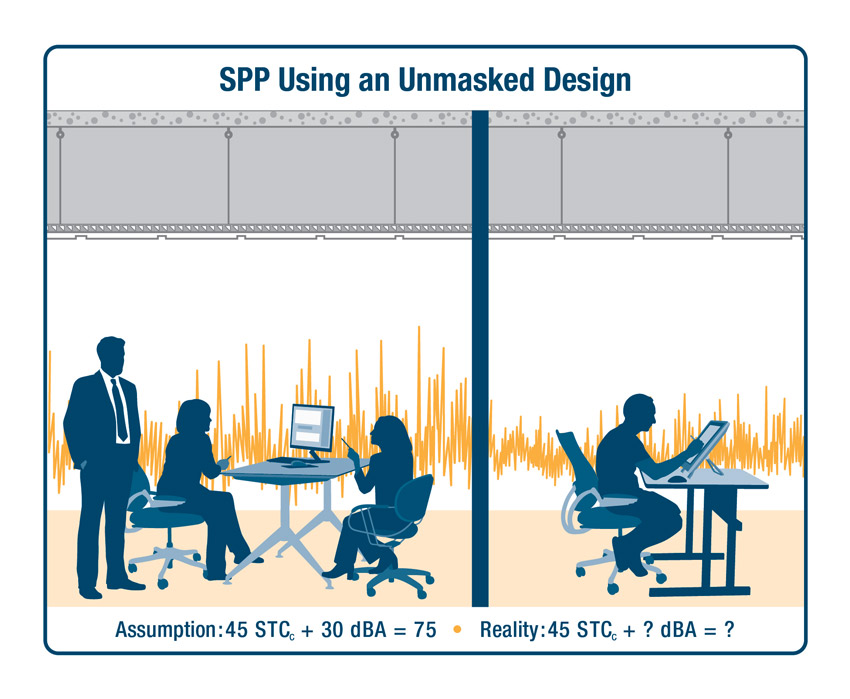

Images courtesy of KR Moeller Associates Ltd.
Top: A design that does not feature sound masking, but rather relies on HVAC to provide an assumed minimum background sound level leads to over-specification of the room’s physical structure, while nonetheless leaving its actual acoustic performance up to chance.
Bottom: A design that utilizes sound masking to establish a known minimum background sound level—even as low as 30 dBA—as well as a spectrum or ‘curve’ designed for speech privacy eliminates the variability of HVAC sound, allowing acoustic goals to be more reliably achieved with the stated STCc.
Sound masking can also be used in combination with walls or demountable partitions built to a suitably ceiling attenuation class (CAC)-rated suspended ceiling in order to provide a cost-effective and more flexible alternative to deck-to-deck construction. For example, a major American health-care provider changed its construction standards for medical office buildings away from deck-to-deck construction. After significant testing of mockup facilities, the company determined that it achieved as good or better speech privacy with ceiling-height walls and sound masking. It reported cost savings of hundreds of thousands of dollars for a project of just over 30,000 square feet (2,787 square meters).

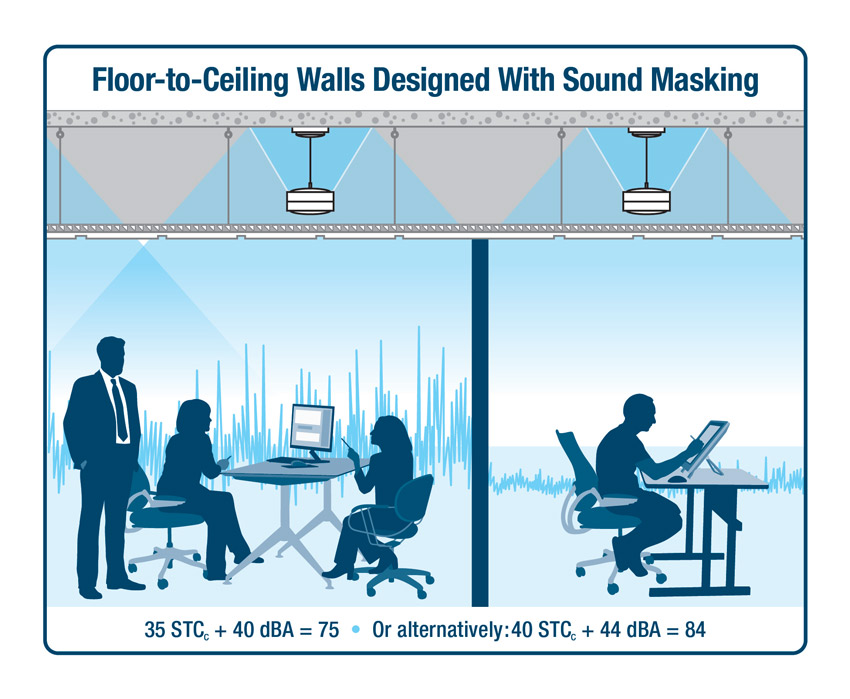
Images courtesy of KR Moeller Associates Ltd.
Top: If the background sound level is set to 35 rather than 30 dBA, STCc can be lowered to 40. Alternatively, using a still moderate level of 40 dBA permits STCc as low as 35 while maintaining a speech privacy potential (SPP) of 75. In fact, value can still be derived by the most cautious of specifiers, even if they take only half the increment in background sound as an STCc reduction. For example, with masking at 40 dBA, rather than drop STCc from 45 to 35, an STCc of 40 plus masking at 40 dBA yields an SPP of 80.
Bottom: Further value engineering and site flexibility can be achieved by specifying room construction with walls built to the suspended ceiling rather than structure. With STCc at 35 and the masking level reliably set to 40 dBA, SPP is 75. If the STCc is increased to 40 and the masking level is raised to 44 dBA, SPP is 84.
There are some cases where one may want to implement both deck-to-deck construction and sound masking; for example, in spaces where raised voices or high-volume media will be used, as well as in areas with high security needs. Also, if the facility features an open ceiling, full-height walls are recommended to ensure some degree of inter-zone isolation.
Meeting the Curve
It should be noted that this type of integrated acoustic design is only viable when the minimum background sound level is precisely generated and consistently delivered.
ASTM acknowledges that variations as small as 2 dBA can significantly influence speech privacy, while other studies indicate that, regardless of design, even a single dBA affects comprehension by up to 10 percent and, in almost every situation, impacts AI by 0.0333. Variations in spectral quality can have similarly negative effects. Therefore, it is incumbent upon those responsible for acoustic design and planning to ensure that the sound-masking system is designed and implemented with due consideration for these stringent requirements.
Unlike ‘white noise’ or ‘pink noise’—terms often, but mistakenly, used—sound masking follows a nonlinear curve specifically designed to balance acoustic control and occupant comfort. A successful implementation involves achieving both goals. No sound-masking system can accomplish these objectives ‘out of the box.’ Regardless of its design, where its loudspeakers are located, or whether they face upward or downward, the sound changes as it interacts with various elements across the facility’s interior. In order to meet the curve, the sound must be tuned.
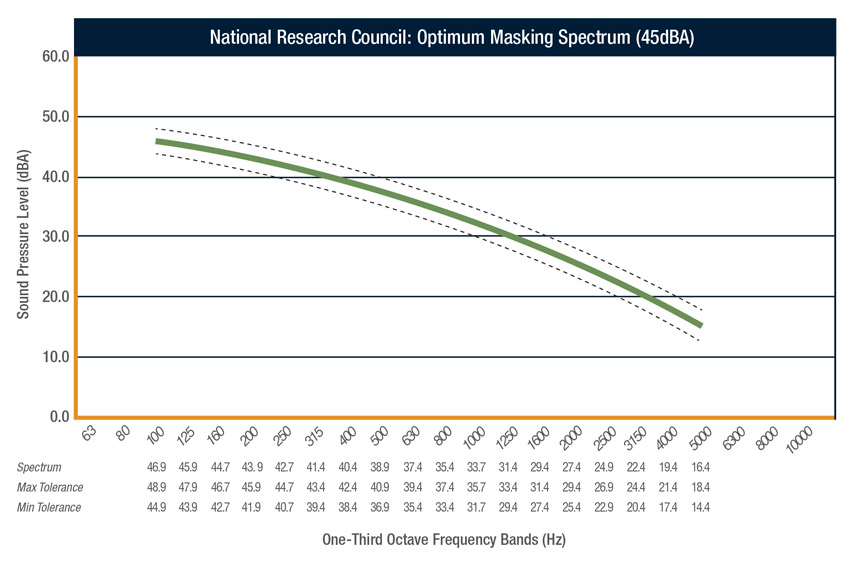
Image courtesy of KR Moeller Associates Ltd.
Shown are the National Research Council’s (NRC) optimum masking spectrum, as well as one-third octave band tolerances of ±2 dBA.
Tuning should be handled after the ceilings and furnishings are in place. Because activity and conversation prevent accurate measurement, it should also be done prior to occupation of the facility or after hours. The exact method varies by product, but basically, an acoustician or trained technician measures the sound at ear height (i.e., the level at which occupants experience its effects), examines the results, and adjusts the system’s volume and frequency settings accordingly. These steps are repeated until they curve is met at each tuning location.
Because it is impossible to achieve perfection in every location, a masking specification will also include a ‘tolerance’ indicating how much the sound is allowed to deviate from the target curve across the treated space. However, as noted above, it is vital to keep this value to a minimum. Outdated specifications might allow for a wide tolerance of ±2 dBA (i.e., giving an overall range of 4 dBA across the space), resulting in a 40 percent performance loss in unpredictable locations across the facility, as indicated by Graph 2.

Image courtesy of KR Moeller Associates Ltd.
AI tests reveal the importance of properly tuning the sound masking in order to prevent large (i.e., greater than 1 dBA) variations in coverage across the space.
When designed with small zones of one to three loudspeakers offering fine volume (i.e., 0.5 dBA) and frequency (i.e., 1/3 octave) control, a computer-tuned networked sound-masking architecture can provide consistency in the overall masking level not exceeding ±0.5 dBA (i.e., 1 dBA overall), yielding much better results than earlier architectures developed in the 1960s and 70s.
Typing the word ‘privacy’ into any search engine yields a virtually endless stream of entries describing the ways in which this basic human right can be violated. There are reports of hackers acquiring credit card information, law enforcement agencies mining social networking sites, and members of the public using drones to take aerial photographs. More recent headlines indicate that voice-activated electronics can eavesdrop on their owners.
Our preoccupation with the vulnerabilities exposed by the internet and electronic products is understandable given their relatively rapid spread into almost every aspect of our lives. However, we should not lose sight of the fact that privacy can still be violated in ‘traditional’ ways. In fact, it can even be lost to those who do not intend to infringe upon it. People are often exposed to sensitive information simply by being within audible range of a conversation.
Current privacy legislation tends to focus on securing access to information stored on computers or within filing cabinets, but attention also needs to be paid to our built environment. When examined in this context, privacy has both an acoustic and a visual component. This course primarily focuses on the former, except insofar as it is affected by the latter.
What is Acoustic Privacy?
Many immediately equate acoustic privacy with speech privacy, but there is more to this concept than the ability to clearly hear what another person is saying.
For example, even if the conversation taking place in the room next to you is unintelligible, you may still be able to identify the speaker’s tone and ascertain whether they are happy, sad, or angry. This type of information can be considered private under certain circumstances, such as when issuing from behind the closed door of a human resources manager’s office. The same can be said for nonverbal noises like those overheard from an adjacent hotel room.
How much we understand of a conversation also depends on whether or not we can see the speaker. This effect—known as visual cues—has been quantified by various studies. Generally speaking, if you can only understand 20 percent of someone’s conversation when you are not looking at them, the ability to see their lips increases that amount to nearly 55 percent. If you start at 50 percent, visual cues increase it to almost 90. In other words, there is also a visual component to acoustic privacy, which is important to bear in mind when designing a space.
Furthermore, acoustic privacy should not only be considered from the perspective of the person speaking but also that of the listener(s). The reasons will become clear when we explore the various impacts of a lack of privacy.

If we visit a medical clinic and hear what is happening in the adjacent examination room, we might be less inclined to disclose information to the nurse or doctor, knowing that we too can be overheard.
Where is it Needed?
A lack of acoustic privacy carries real risk, particularly in facilities where there is a perceived need for it or an expectation on the part of its users. Examples that readily spring to mind include hospitals, bank branches, law offices, government, and military facilities. However, other types of spaces—such as commercial offices, call centers, and hotels, to name but a few—have privacy needs as well. The degree required typically depends on the type of activities the space hosts.
Why is it Needed?
It is easy to understand the need for acoustic privacy—or even acoustic security—from a speaker’s perspective, particularly in environments where they are discussing medical information, financial planning, personal relationships, trade secrets, matters of national security, and similarly confidential topics. However, a lack of acoustic privacy can have impacts beyond divulging sensitive information to unintended parties. This fact becomes clear when we shift our perspective from the person talking to that of the involuntary listener.
When a noise or voice enters ‘our space,’ some degree of annoyance is typical, but it can also make us feel as though our privacy is being invaded or our sense of physical separation from others violated. Perhaps the most relatable examples of this sensation are when the guest in a neighboring hotel room turns up the television volume or the patient at the other end of a waiting area starts speaking loudly into a cell phone.
If we can inadvertently hear a conversation, we can also become self-conscious about our own level of privacy. In some contexts, it can create a sense of unease, which in turn impacts our ability to freely communicate. For instance, if we visit a medical clinic and hear what is happening in the adjacent examination room, we might be less inclined to disclose information to the nurse or doctor, knowing that we too can be overheard.
The degree of acoustic privacy afforded by the built environment can even impact an organization’s brand image. We want to be in control of our personal information when meeting with a financial or legal advisor, for example, and a positive acoustic experience can reinforce our confidence in the firm. This level of protection is also indispensable for staff to effectively negotiate the terms of various agreements.
In some countries, protecting verbal communication within particular types of facilities is actually mandated by law. The Health Insurance Portability and Accountability Act (HIPAA) introduced by the U.S. Department of Health and Human Services in 1996 is a good example. It requires health-care entities to take “reasonable safeguards” to ensure speech privacy during both in-person and telephone conversations with patients and between employees.
Acoustic privacy is also vital to employees’ overall satisfaction with their workplace. A decade-long survey of 65,000 people run by the Center for the Built Environment (CBE), University of California, Berkeley, found that lack of speech privacy is the number-one complaint in offices. Participants expressed irritation at being able to overhear in-person and telephone communications, as well as concern for their own level of privacy.
What About the Open Plan?
The topic of workplace satisfaction also emphasizes the need to consider those occupying spaces other than closed rooms. Though some may dismiss the importance of acoustic privacy when designing an open plan, studies show that it has a significant impact on productivity.
For instance, research conducted by Finland’s Institute of Occupational Health shows that unwilling listeners demonstrate a 5 to 10 percent decline in performance when undertaking tasks such as reading, writing, and other forms of creative work. Simply hearing that someone is speaking can disturb concentration, but this problem is greatly magnified when you can clearly understand what they are saying because, if you can follow a conversation, it is much harder to ignore it.
Though an organization might not consider privacy a goal within an open plan, it is impossible to justify increasing disruptions. Taking the steps required to lower speech intelligibility within this type of space increases occupants’ output and reduces error rates.
Assessing Speech Intelligibility
But how do we assess speech intelligibility within the built environment?
To begin, we cannot talk about this subject without getting into the concept of degrees because we do not need to understand every word of a conversation in order for privacy to be violated. Due to the redundancies and patterns in speech, we can follow much of what is said even if we only hear half of it, and particularly if we have previously been part of a similar conversation. Furthermore, private details can be exposed even if we only hear a small part of the discussion.
We must also acknowledge that it is very difficult to subjectively assess degrees of speech intelligibility. For example, a listener would have a hard time indicating with any precision whether they can understand 40, 55, or 70 percent of what someone else is saying.
Fortunately, there are ways to measure and quantify the degree of privacy afforded by a built environment. The Articulation Index (AI) remains the most widely used method. It was developed at Bell Labs in 1921 by Harvey Fletcher as he sought to quantify speech comprehension over telephone lines. During the 1950s, those involved in the speech privacy sciences adopted his invention as a measure of exactly the opposite: how much one could not understand.
To calculate AI, one uses a test signal that includes the frequencies known to specifically impact speech comprehension. This signal is measured at 1 meter from the ‘source’ and again at the ‘listener’ location. The background sound level is also measured at the ‘listener’ location in order to quantify how loud the test signal is relative to it—a value known as the signal-to-noise ratio (SNR). This value is critical, because the lower the SNR, the less the intelligibility and the greater the speech privacy. For AI, SNR is measured in each of 15 frequency ranges (from 200 to 5,000 Hz). Each of these ranges is weighted according to the degree to which it contributes to speech comprehension. The final AI value ranges from 0 (where conversation is completely unintelligible) to 1.0 (where everything is heard and understood).
AI ratings are challenging to interpret in a meaningful way so studies have been done to correlate them to subjective ‘privacy’ categories; however, the value of these groupings is somewhat diluted by the wide range of comprehension within each one. ‘Confidential’ privacy ranges from 0 to 0.1, ‘normal’ from 0.1 to 0.2, and ‘marginal’ from 0.2 to 0.3. If AI is above 0.3, there is effectively no privacy.
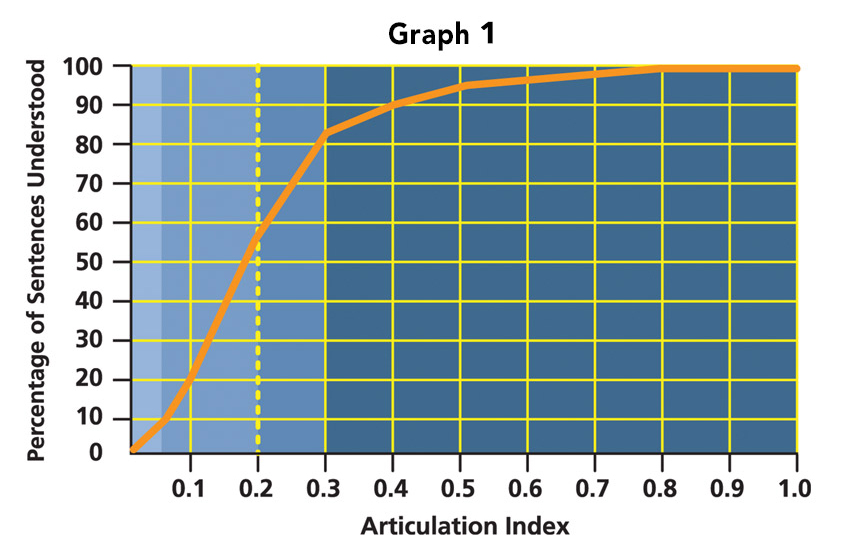
Image courtesy of KR Moeller Associates Ltd.
The relationship between Articulation Index (AI) and intelligibility is not linear. For example, a value of 0.5 means that a listener can understand approximately 95 percent of a conversation, not 50 percent. A very low AI value is required for true privacy.
As shown in Graph 1, the relationship between AI and actual comprehension is not linear. On a 0-1.0 scale, many would expect a value of 0.5 to mean that a listener would understand 50 percent of a conversation, but—as is clear from the graph—they would actually understand approximately 95 percent. The shaded areas along the left of the graph show the confidential, normal, and marginal privacy ranges, indicating just how low an AI is required for true privacy.
A more recent arrival on the acoustical scene is a metric called the Privacy Index (PI). PI is based on AI, in that it is calculated as 1 minus the AI value, multiplied by 100, and expressed as a percentage; in other words, 1 - AI x 100 = PI (%).
However, PI can be misleading. Part of the problem likely stems from its use of the word ‘privacy,’ which can cause users to come to the wrong conclusion about the rating’s meaning. The fact that it is expressed as a percentage creates even more potential for confusion. For example, with an AI of 0.3, you arrive at a PI of 70 percent. If you refer to Graph 1, the reason to avoid this metric is obvious. When told the PI is 70 percent, most people would assume that they would only understand 30 percent of what is being said. In reality, you would understand nearly 85 percent. Therefore, building professionals should be cautious when investigating acoustical solutions and interpreting related PI statements.
How Sound Travels
In order to design the built environment for acoustic privacy, it is also important to understand the three ways in which sound—and, hence, voice—travels to a listener.
Sound follows a direct path when it travels uninterrupted from the source to the listener or penetrates a barrier between them, such as a wall. This transmission path contributes the most to high levels of speech reaching the listener. However, it can also travel on a reflected path. This type of transmission occurs when sound bounces off of the various surfaces within the space, such as the floors, ceilings, walls, and furniture. Finally, sound can travel in a diffracted path—that is, it can bend around obstacles. This pathway is generally less significant than the first two.
Because speech travels in these various ways, it can be difficult to contain. Several methods must be utilized because no single technique can sufficiently address all transmission pathways.
Designing For Acoustic Privacy
Traditionally, acoustic professionals have used a multipronged approach called the ABC Rule, which stands for absorb, block, and cover. While most people are well-acquainted with the first two strategies—using walls, doors, workstations, and a well-planned layout to physically block voices and noises, as well as the benefits of installing ceiling tiles, wall panels, and soft flooring to absorb them—fewer understand cover, often leading to over-specification of physical construction, increased costs, and reduced flexibility, with nonetheless unpredictable results.
Given the critical role background sound plays in achieving acoustic privacy, it is advantageous to turn the ABC Rule on its head and begin with ‘C’ instead.
‘C’ involves using a sound-masking system to control the minimum background sound level. Though many compare this technology’s output to that of softly blowing air, it is specifically engineered to cover the range of frequencies in human speech, improving privacy. The sound also covers up incidental noises or minimizes their disruptive impact on occupants by reducing the amount of change between baseline and peak levels within the space. This is a type of effect with which most people are familiar. Everyday examples include the drone of an airplane engine, the murmur of a crowd in a busy restaurant, the hum of highway traffic, and the rustling of leaves in the wind. All have the potential to mask sounds a listener would otherwise hear.
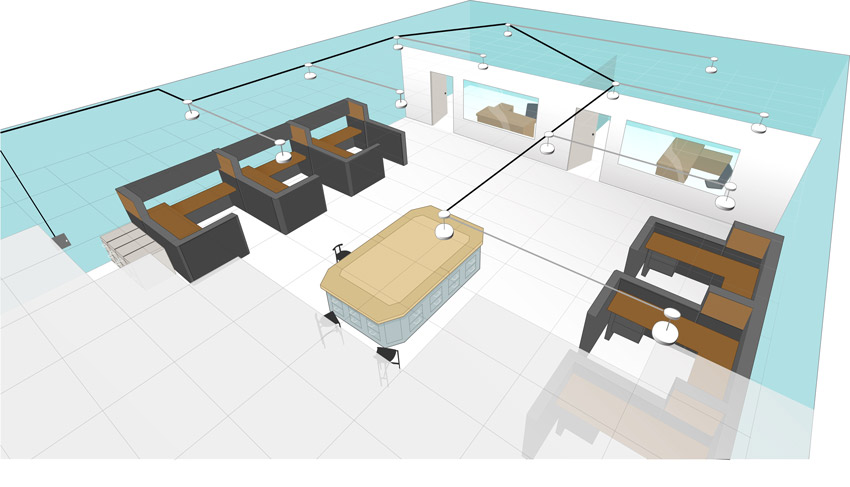
Image courtesy of KR Moeller Associates Ltd.
A sound-masking system consists of a series of electronic components and loudspeakers that distribute a sound specifically engineered to balance acoustic control with occupant comfort.
Due to improvements in construction materials as well as quieter equipment, the background sound level in the majority of facilities is too low. The pin-drop conditions allow occupants to easily hear conversations occurring at a distance and even from within closed rooms. Though they typically describe their workplace as ‘noisy,’ the root of the problem is that it is, in fact, too ‘silent.’ Put another way, the absence of continuous background sound makes noises and conversations easier to hear.
Unless a sound-masking system is implemented—as well as professionally tuned and its performance verified post installation—a facility’s minimum background sound level is unknown. HVAC and other mechanical systems are sometimes thought to provide masking, but one cannot reasonably expect this type of equipment to deliver a consistent level over time or space. Even if well designed, its output is only governed in that it is not to exceed maximums defined by the American Society of Heating, Refrigerating, and Air-Conditioning Engineers in the 2013 ASHRAE Handbook—Fundamentals. Unlike masking technology, it cannot control the minimum background sound level or generate a spectrum conducive to speech privacy.
Accordingly, ASTM E1374: Standard Guide for Open Office Acoustics and Applicable ASTM Standards was recently revised. The discussion of HVAC noise in the newly released ASTM E1374-18: Standard Guide for Office Acoustics and Applicable ASTM Standards pertains only to limiting maximum noise levels rather than using this equipment for masking. Further, a sound-masking system is identified as the only viable source of a continuous minimum background sound level. As the title change suggests, this standard’s scope has also been broadened; it now applies to private offices and conference rooms, not only to open plan.
Mind the Gaps
Generally speaking, an occupant’s expectation of acoustic privacy is higher in closed rooms than within an open plan. However, many continue to exclude sound masking from private offices and meeting rooms, primarily in the belief that closed spaces are afforded sufficient speech privacy and noise control via physical isolation. By the same token, when a closed room fails to provide this quality, it is blamed on deficiencies in its design, construction, and/or maintenance.
While they might be contributing factors, this failure cannot solely be attributed to cracks in the walls’ armor because speech privacy is not determined by isolation alone. As described earlier—and set out in ASTM E2638: Standard Test Method for Objective Measurement of the Speech Privacy Provided by a Closed Room—a person’s ability to clearly understand a conversation is not only dependent on the level of the speaker’s voice but on the background sound level in the listener’s location.
Traditional closed-room construction attempts to provide privacy by simply reducing the signal. Speech privacy levels fluctuate from wall assembly to wall assembly, depending on their performance in the frequencies used to calculate the sound transmission class (STC), their site-tested apparent STC (ASTC) as opposed to STC rating, the inconsistent noise level and spectrum the HVAC system generates, and various flanking paths—gaps along the window mullions, ceiling and floors, as well as through the plenum, ductwork, return air grills, and open doors. If a solution has not been implemented to control the minimum background sound level in adjoining areas and it is lower than the sounds passing through the wall or via leakages, conversations will still be heard and potentially intelligible.
With advances made in sound-masking technology, a minimum background sound level is now a readily deliverable component of architectural acoustic design. Using it—even to apply a level as low as the 30 A-weighted decibels (dBA) on which STC ratings, and hence wall choices, are based—allows the expected degree of speech privacy to be more reliably achieved.
One also has the opportunity to increase the minimum background sound level if the partition construction fails to live up to its rating. The level traditionally recommended in most closed rooms is 40 to 45 dBA, leaving a range of adjustment at the facility manager’s disposal.
Speech Privacy Potential
At 30 dBA, the masking sound is barely audible and yet provides the minimum necessary to accurately plan the remaining elements of the acoustical design. However, there are significant opportunities for further value engineering. As partition attenuation increases, for each decibel reduction there is an increase in speech privacy levels. Mathematically, the same can be achieved by raising the background sound level by a decibel.
When preparing “Sound & Vibration 2.0: Design Guidelines for Health Care Facilities”—the companion document to the Facility Guidelines Institute’s (FGI) “2014 Guidelines for Design and Construction of Hospitals and Outpatient Facilities”—acousticians developed a formula that provides a predictive model for this approach. Basically, to “achieve confidential speech privacy, the sum of the composite STC and the A-weighted background noise level shall be at least 75,” or STCc + dBA ≥ 75. Some refer to this formula as speech privacy potential (SPP). Though developed with a particular type of facility in mind, most people expect conversations occurring within closed rooms to remain private, making SPP more broadly applicable. Note that STCc includes the negative impact on acoustic performance when elements such as doors and windows are added to the partition.
If speech privacy equals STCc + 30 dBA ≥ 75, then for every 1 dBA increase in the background sound level, it is possible to reduce STCc by one point and achieve the equivalent level of speech privacy. Were the background sound to be increased from 30 dBA to 35 dBA, for instance, construction costs for partition types would start to drop significantly because the STCc could be reduced by five points. Again, 30 dBA—and, indeed, even 35 dBA—is well below typical masking levels in closed rooms. Usually, they are set to between 40 and 45 dBA in such spaces.


Images courtesy of KR Moeller Associates Ltd.
Top: A design that does not feature sound masking, but rather relies on HVAC to provide an assumed minimum background sound level leads to over-specification of the room’s physical structure, while nonetheless leaving its actual acoustic performance up to chance.
Bottom: A design that utilizes sound masking to establish a known minimum background sound level—even as low as 30 dBA—as well as a spectrum or ‘curve’ designed for speech privacy eliminates the variability of HVAC sound, allowing acoustic goals to be more reliably achieved with the stated STCc.
Sound masking can also be used in combination with walls or demountable partitions built to a suitably ceiling attenuation class (CAC)-rated suspended ceiling in order to provide a cost-effective and more flexible alternative to deck-to-deck construction. For example, a major American health-care provider changed its construction standards for medical office buildings away from deck-to-deck construction. After significant testing of mockup facilities, the company determined that it achieved as good or better speech privacy with ceiling-height walls and sound masking. It reported cost savings of hundreds of thousands of dollars for a project of just over 30,000 square feet (2,787 square meters).


Images courtesy of KR Moeller Associates Ltd.
Top: If the background sound level is set to 35 rather than 30 dBA, STCc can be lowered to 40. Alternatively, using a still moderate level of 40 dBA permits STCc as low as 35 while maintaining a speech privacy potential (SPP) of 75. In fact, value can still be derived by the most cautious of specifiers, even if they take only half the increment in background sound as an STCc reduction. For example, with masking at 40 dBA, rather than drop STCc from 45 to 35, an STCc of 40 plus masking at 40 dBA yields an SPP of 80.
Bottom: Further value engineering and site flexibility can be achieved by specifying room construction with walls built to the suspended ceiling rather than structure. With STCc at 35 and the masking level reliably set to 40 dBA, SPP is 75. If the STCc is increased to 40 and the masking level is raised to 44 dBA, SPP is 84.
There are some cases where one may want to implement both deck-to-deck construction and sound masking; for example, in spaces where raised voices or high-volume media will be used, as well as in areas with high security needs. Also, if the facility features an open ceiling, full-height walls are recommended to ensure some degree of inter-zone isolation.
Meeting the Curve
It should be noted that this type of integrated acoustic design is only viable when the minimum background sound level is precisely generated and consistently delivered.
ASTM acknowledges that variations as small as 2 dBA can significantly influence speech privacy, while other studies indicate that, regardless of design, even a single dBA affects comprehension by up to 10 percent and, in almost every situation, impacts AI by 0.0333. Variations in spectral quality can have similarly negative effects. Therefore, it is incumbent upon those responsible for acoustic design and planning to ensure that the sound-masking system is designed and implemented with due consideration for these stringent requirements.
Unlike ‘white noise’ or ‘pink noise’—terms often, but mistakenly, used—sound masking follows a nonlinear curve specifically designed to balance acoustic control and occupant comfort. A successful implementation involves achieving both goals. No sound-masking system can accomplish these objectives ‘out of the box.’ Regardless of its design, where its loudspeakers are located, or whether they face upward or downward, the sound changes as it interacts with various elements across the facility’s interior. In order to meet the curve, the sound must be tuned.

Image courtesy of KR Moeller Associates Ltd.
Shown are the National Research Council’s (NRC) optimum masking spectrum, as well as one-third octave band tolerances of ±2 dBA.
Tuning should be handled after the ceilings and furnishings are in place. Because activity and conversation prevent accurate measurement, it should also be done prior to occupation of the facility or after hours. The exact method varies by product, but basically, an acoustician or trained technician measures the sound at ear height (i.e., the level at which occupants experience its effects), examines the results, and adjusts the system’s volume and frequency settings accordingly. These steps are repeated until they curve is met at each tuning location.
Because it is impossible to achieve perfection in every location, a masking specification will also include a ‘tolerance’ indicating how much the sound is allowed to deviate from the target curve across the treated space. However, as noted above, it is vital to keep this value to a minimum. Outdated specifications might allow for a wide tolerance of ±2 dBA (i.e., giving an overall range of 4 dBA across the space), resulting in a 40 percent performance loss in unpredictable locations across the facility, as indicated by Graph 2.

Image courtesy of KR Moeller Associates Ltd.
AI tests reveal the importance of properly tuning the sound masking in order to prevent large (i.e., greater than 1 dBA) variations in coverage across the space.
When designed with small zones of one to three loudspeakers offering fine volume (i.e., 0.5 dBA) and frequency (i.e., 1/3 octave) control, a computer-tuned networked sound-masking architecture can provide consistency in the overall masking level not exceeding ±0.5 dBA (i.e., 1 dBA overall), yielding much better results than earlier architectures developed in the 1960s and 70s.
Demonstrating the Impact
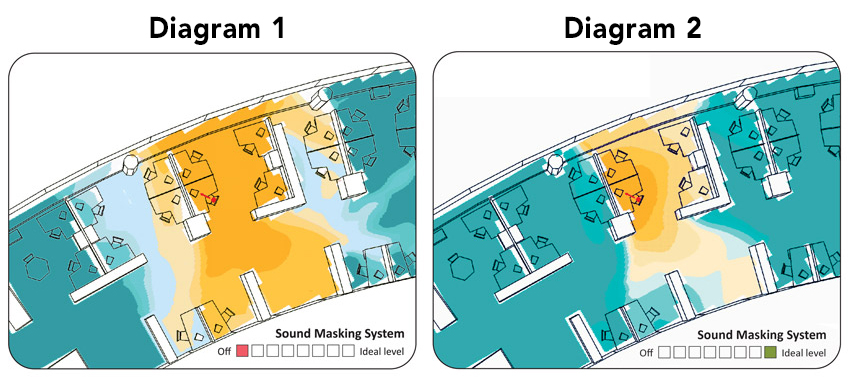
Images courtesy of KR Moeller Associates Ltd.
In Diagram 1, the area of intelligibility around a speaker is not circular. Its shape is determined by numerous factors including, the orientation of the person speaking as well as the physical barriers and absorptive/reflective materials used within the space. In Diagram 2, when sound masking is applied, the area of intelligibility shrinks.
As shown in Diagram 1, the area of intelligibility around an individual is not a simple circle. Rather, it is a complex shape determined by numerous factors, including the speaker’s orientation, physical barriers, and absorption/reflection.

Image courtesy of KR Moeller Associates Ltd.
In Diagram 3, AI tests were conducted between these two workstations to determine how much of an impact sound masking has on speech intelligibility, even within an otherwise acoustically well-designed space.
In any space, voices and noises diminish in volume over distance. However, background sound levels are often so low in indoor environments that speech carries intelligibly over 30 to 50 feet (9 to 15 meters) or more in open space. By increasing the background sound level, sound masking reduces the signal-to-noise ratio (SNR). As shown in Diagram 2, voices disappear below the new level after a much shorter distance.

Image courtesy of KR Moeller Associates Ltd.
The results of the AI tests show that, despite using absorption and blocking strategies, speech comprehension remains nearly 85 percent until sound masking is applied. Comprehension drops by an average of 10 percent for each decibel of increase in the masking volume.
The exact length is, of course, a function of the entire acoustic design of the space. However, as illustrated by the AI measurements conducted between the two workstations shown in Diagram 3, sound masking plays an integral role. This open-plan area’s acoustical design was suitably planned. The partitions are 65 inches (1651 mm) tall and perform well in terms of both absorption and isolation. The ceiling tiles are highly absorptive (0.95 NRC). The lighting system is indirect so as to not reflect too much voice/noise back down into neighboring work areas. A sound-masking system is installed above the suspended ceiling.
Graph 3 shows the results of the AI tests conducted between the two workstations. Despite the high-performance acoustical design elements, speech comprehension is nearly 85 percent when the sound-masking system is off because the existing background sound level is only 40.6 dBA. When the system is turned on, comprehension quickly declines. In fact, for each decibel of increase in masking volume, comprehension drops by an average of 10 percent.
The AI tests also illustrate the importance of keeping tolerance as low as possible and consistently meeting the specified sound-masking curve throughout the facility. In this example, two occupants sit approximately 4.7 m (15.5 ft) apart within the open plan. As indicated by Graph 3, with the masking set to 48 dBA with a narrow tolerance of ±0.5 dBA, the listener can understand just 14 to 25 percent. When a broader tolerance of ±2 dBA is applied, the listener can understand up to 59 percent—barely an improvement over the unmasked conditions.
A Word About Workstations
While sound masking is increasingly at the forefront of open-plan design, another important strategy—blocking—is disappearing from these areas. This trend has had a dramatic impact on their acoustic performance because though other treatments can reduce overall volume levels and deal with noises generated from farther away, they have no effect over short distances. When barriers are dispensed with, local noise sources remain highly intelligible and disruptive. The ability to see and be seen further reduces privacy due to our natural capacity for lip reading.
Again, though some might argue that privacy is not expected nor needed within the open plan, understandable speech disrupts occupants’ concentration. For this reason, workstation partitions should be no lower than seated head height (1524 to 1651 mm; 60 to 65 in.). Even the direction in which a person faces affects his or her voice’s volume within the neighboring workspace; therefore, occupants should be seated facing away from each other on either side of partitions.
Speech Security
Though this course focuses on acoustic privacy rather than acoustic security (such as may be required by military facilities, corporate boardrooms, laboratories, and so on), it may be interesting for readers to know that—without the proper treatment—windows, doors, ducts, pipes, floors, ceilings, and walls present opportunities for electronic forms of eavesdropping. Speech causes vibrations on these structures, which can be picked up by probes or microphones and translated into intelligible speech. These types of listening devices are difficult to detect because they can be used at a considerable distance from the target facility.
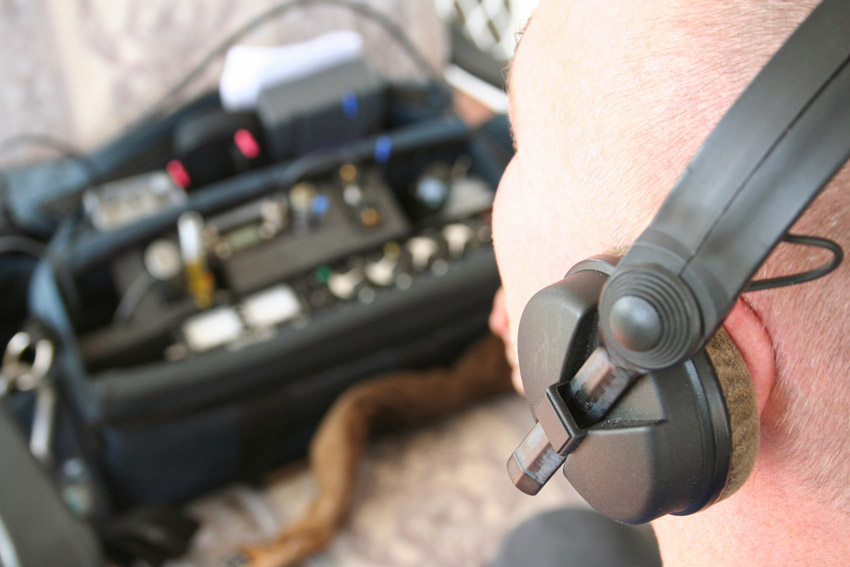
Voices cause vibrations in windows, doors, pipes, and walls, which can be picked up by audio surveillance equipment and translated into intelligible speech. Sound masking can be applied to these structures in order to help protect privacy.
If an organization suspects that it might be subject to such a threat, a sound-masking system can be connected to transducers, which transfer the masking sound to the aforementioned physical structures, impeding the use of audio surveillance equipment. In this case, it is key to ensure that the system produces a truly random masking sound (i.e., rather than on a loop) so that it cannot be filtered out of recordings.
In Conclusion
Attention must be paid to the topic of acoustic privacy within our built environment. Though this conclusion is obvious to organizations that consistently deal with sensitive information, the methods they utilize to achieve it are the same as those needed to accomplish other valuable acoustic goals—the only difference is how one sees the benefit: from the perspective of the person talking or that of the group listening. People working in an acoustically comfortable environment have an easier time concentrating on their tasks and also suffer less stress and fatigue. An organization may decide that it is more motivated by the need for a high-performance workplace than acoustic privacy, but taking the steps required to lower speech intelligibility allows it to reap both rewards.
Background sound is key to achieving this goal. By turning the traditional three-tiered approach of absorb, block, and cover—collectively known as the ABC Rule—on its head and using ‘C’ as the starting point for interior planning, building professionals can more accurately specify the blocking and absorptive elements used in their designs. In other words, this predictable minimum level becomes the canvas on which the rest of the acoustic plan is painted, allowing it to be delivered in a more cost-effective manner and with greater assurance of achieving the intended results.
Niklas Moeller is vice president of KR Moeller Associates Ltd., manufacturer of the LogiSon Acoustic Network and MODIO Guestroom Acoustic Control. He has more than 25 years experience in the sound-masking field.

|
Today’s interiors are even more dependent on sound masking for speech privacy and noise control. The LogiSon Acoustic Network is tuned using TARGET, an application that accurately adjusts each small zone to the specified spectrum, maximizing benefits and occupant comfort. Worldwide distributors provide turnkey services and support.
www.logison.com
|


























